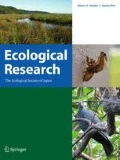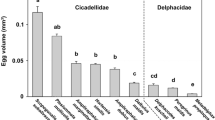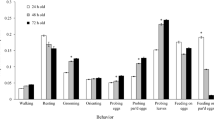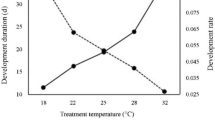Abstract
The adaptive significance of egg size of skippers (Lepidoptera; Hesperiidae) in Japan was evaluated in relation to the leaf toughness of their major host grasses. The hesperids that fed on tougher grasses laid larger eggs. Hesperids that laid larger eggs were larger in body size, but lower in fecundity. They also had a wider host range. Thus, despite the lower fecundity, hesperids may benefit from large eggs by having a wider host range of larvae. Grass feeders had wider range of host plants than broadleaf feeders.
Similar content being viewed by others
References
Berenbaum, M. (1983) Coumarins and caterpillars: A case for coevolution. Evolution37:163–179.
Bernays, E. A. (1986) Diet-induced head allometry among foliage-chewing insects and its importance for graminivores. Science231:495–497.
Blair, C. A. &Groves, J. R. (1952) Biology of the fruit tree red spidermiteMetatetranychus ulmi in South-East England. J. Hort. Sci.27: 14–43.
Boutton, T. W., Cameron, G. N. &Smith, B. N. (1978) Insect herbivory on C3 and C4 grasses. Oecologia36:21–32.
Brody, M. S. &Lawler, L. R. (1984) Adaptive variation in offspring size in the terrestrial isopodArmadillidium vulgare. Oecologia61:55–59.
Cates, R. G. &Rhoades, D. F. (1977) Patterns in the production of antiherbivore chemical defenses in plant communities. Biochem. Syst. Ecol.5:185–193.
Chew, F. S. (1975) Coevolution of pierid butterflies and their cruciferous food plants. The relative quality of available resources. Oecologia20:117–127.
Courtney, S. P. (1981) Coevolution of pierid butterflies and their cruciferous food plants. III.Anthocharis cardamines (L.) survival, development and oviposition on different host plants. Oecologia51:91–96.
Ehrlich, P. R. &Raven, P. H. (1964) Butterflies and plants: A study in coevolution. Evolution18: 586–608.
Feeny, P. (1970) Seasonal changes in oak leaf tannins and nutrients as a cause of spring feeding by winter moth caterpillars. Ecology51:565–581.
— (1976) Plant apparency and chemical defense. Rec. Adv. Phytochem.10:1–40.
Fujioka, T. (1975) Butterflies of Japan. Kodansha, Tokyo (In Japanese).
Fukuda, H., Hama, E., Kuzuya, T., Takahashi, A., Takahashi, M., Tanaka, H., Wakabayashi, M. &Watanabe, Y. (1984) The life histories of butterflies in Japan. IV. Hoikusha, Osaka (In Japanese with English summary).
Futuyma, D. J., Cort, R. P. &van Noordwijk, I. (1984) Adaptation to host plants in the fall cankerworm (Alsophila pometaria) and its bearing on the evolution of host affiliation in phytophagous insects. Am. Nat.123:287–296.
Gilbert, L. E. (1975) Ecological consequences of a coevolved mutualism between butterflies and plants. “Coevolution of animal and plants” (ed. Gilbert, L. E. & Raven, P. H.), 210–240. University of Texas Press, Austin.
Gutzke, W. H. N. &Packard, G. C. (1985) Hatching success in relation to egg size in painted turtles. Can. J. Zool.63:67–70.
Harvey, G. T. (1977) Mean weight and rearing performance of successive egg clusters of eastern spruce budworm (Lepidoptera: Tortricidae). Can. Ent.109:487–496.
Heidorn, H. &Joern, A. (1984) Differential herbivory on C3 versus C4 grasses by the grasshopperAgeneotettix deorum (Orthoptera: Acrididae). Oecologia69:19–25.
Ishi, M. &Hidaka, T. (1979) Seasonal polymorphism of adult rice skipperParnara guttata guttata (Lepidoptera: Hesperiidae) and its control. Appl. Ent. Zool.14:173–184.
Jermy, T. (1984) Evolution of insect/host plant relationships. Am. Nat.124:609–630.
Karlsson, B. &Wiklund, C. (1985) Egg weight variation in relation to egg mortality and starvation endurance of newly hatched larvae in some stayrid butterflies. Ecological Entomology10:205–211.
Kimura, T. &Masaki, S. (1977) Brachypterism and seasonal adaptation inOrgyia thyellina Butler (Lepidoptera: Lymantriidae). Kontyu, Tokyo45:97–106.
Lees, A. D. (1955) The physiology of diapause in arthropods. Oxford Univ. Press, Cambridge.
Mashiko, K. (1982) Differences in both the egg size and clutch size of the freshwater prawnPalaemon paucidens de Haan in Sagami River. Jap. J. Ecol.32:445–451.
Masuzawa, T., Suwa, H. &Nakasuji, F. (1983) Differences of oviposition preference and survival rate of two skipper butterfliesParnara guttata andPelopidas mathias (Lepidoptera: Hesperiidae) on rice plant and cogon grass. New Entomologists32:47–56.
Marsh, E. (1986) Effects of egg size on offspring fitness and maternal fecundity in the orange throat darter,Etheostoma spectabile (Pisces: Percidae). Copeia No.1:18–30.
Nakasuji, F. (1982) Seasonal changes in native host plants of a migrant skipper,Parnara guttata Bremer et Grey (Lepidoptera: Hesperiidae). Appl. Ent. Zool.17:146–148.
— (1984) Seasonal polymorphism of egg size in a migrant skipper,Parnara guttata guttata (Lepidoptera: Hesperiidae). Kontyu, Tokyo52:253–259.
— (1984) Rice skippers in Taiwan and their life histories. Tech. Bull. Food. and Fertilizer Technology Center, Taipei No.82:1–10.
Ono, T. &Nakasuji, F. (1980) Comparison of flight activity and oviposition characteristics of seasonal forms of a migrant skipperParnara guttata guttata. Kontyu, Tokyo48:226–233.
Price, P. E. (1977) General concepts on the evolutionary biology of parasites. Evolution31:405–420.
Richards, L. &Myers, J. H. (1980) Maternal influence on size and emergence time of the cinnabar moth. Can. J. Zool.58:1452–1457.
Scriber, J. M. &Feeny, P. (1979) Growth of herbivorous caterpillars in relation to feeding specialization and to the growth form of their food plants. Ecology60:829–850.
Shinoda, T. (1963) Diameter of eggs of three skipper species. Kakouchyo15:49–55 (In Japanese).
Shirôzu, T. &Hara, H. (1962) Butterfly larvae in Japan. II. Hoikusha, Osaka (In Japanese).
Smiley, J. T. (1985) Are chemical barriers necessary for evolution of butterfly-plant associations? Oecologia65:580–583
Tanton, M. T. (1962) The effect of leaf “toughness” on the feeding of larvae of mustard beetlePhaedon cochleariae Fab. Entomol exp. appl.5:74–78.
Taper, M. L. &Case, T. J. (1987) Interactions between oak tannins and parasite community complex: Unexpected benefits of tannins to cinipid gall-wasps. Oecologia71:254–261.
Williams, K. S., Lincoln, D. E. &Ehrlich, P. R. (1983) The coevolution ofEuphydryas chalcedona butterflies and their larval host plants I. Larval feeding behavior and host plant chemistry. Oecologia56:323–329.
Wiklund, C. (1982) Generalist versus specialist utilization of host plants among butterflies. Proc. 5th Int. Symp. Insect-Plant Relationships. Wageningen: 181–191.
— (1983) Fecundity, and the relation of egg weight of offspring fitness in the speckled wood butterflyPararge aegeria, or why don't butterfly females lay more eggs. Oikos40: 53–63.
— (1984) Egg size variation in satyrid butterflies: adaptive vs historical ‘Bauplan”, and mechanistic explanations. Oikos43:391–400.
Author information
Authors and Affiliations
About this article
Cite this article
Nakasuji, F. Egg size of skippers (Lepidoptera: Hesperiidae) in relation to their host specificity and to leaf toughness of host plants. Ecol. Res. 2, 175–183 (1987). https://doi.org/10.1007/BF02346925
Accepted:
Issue Date:
DOI: https://doi.org/10.1007/BF02346925




